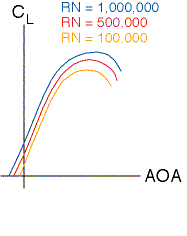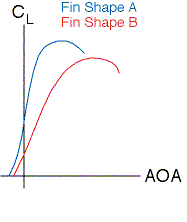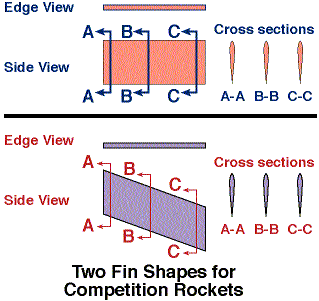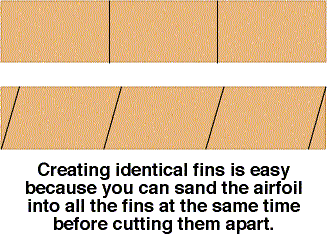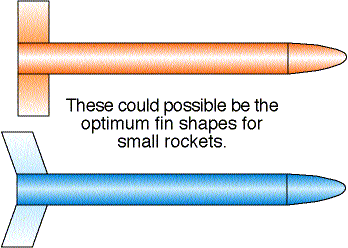Our Tel: 719-535-9335 Apogee Components, Inc. 1130 Elkton Drive, Ste A Colorado Springs, CO 80907 USA | ||||||||||||||||
|
Technical Publication #16 I'm often asked the question of which fin shape is best for small competition rockets. What I'm about to tell you about this may shock you... Many people have been told that the elliptical fin shape has the lowest induced drag. While that may be true for full size airplanes, it may not be necessarily true for small model rockets. The reason is buried in the very technical subject about something called the fin's "Reynolds Number." I'll try to describe this without getting too technical, because I want even young modelers to understand this (I've seen too many science fair projects with the subject being 'optimum fin shapes' -- which you won't find in my book: 69 Simple Science Fair Projects with Model Rockets: Aeronautics).
There are two types of drag on a rocket; induced drag, and profile drag. Induced drag only occurs when the fin creates lift. So if the rocket is flying along nice-and-stable, the fins don't have to create any lift forces to straighten out the flight path of the rocket. Hence, the induced drag on the rocket may be near zero. Therefore, it is highly likely that your rocket will have the same induced drag forces no matter what shape fin you use - because typically a model flies straight and true and the induced drag in the rocket is very, very small. Profile drag on the other hand, is always present. It is a combination of friction drag and pressure drag. The profile drag force is determined by a number of factors, including the surface finish on the fin, airfoil used, area of the fin, the length of the fin chord, and the speed at which the rocket travels. The last two factors are also used with other parameters to determine the Reynolds Number for the rocket. The Reynolds Number is often used to determine the Coefficient of Lift of the fin at various angle of attacks (AOA). You can see from the figure below, that the higher the Reynolds Number, the higher the fins Coefficient of Lift. Therefore, it will be more efficient at creating a restoring force to correct the path of a rocket.
So if your rocket is flying slow, and has very small fins, the Reynolds number might be so low that the fin will be very ineffective (because the Coefficient of Lift will be smaller). And if your rocket starts to stray from a vertical path, the model will cant much further over before the AOA is high enough to force a larger Coefficient of Lift. This will then start to bring the rocket back to vertical, but now the induced drag really starts to increase as does profile drag; because the side of the rocket is exposed to the airflow. This makes it highly desirable to have a fin that has a high Coefficient of Lift, so the model quickly restores to the correct flight path when the AOA is still small. If you look around for data, you will find that the Coefficient of Lift is determined by the airfoil of the fin, not its shape. We will now see that the wrong shape can make the situation even worse.
The most efficient part of the fin is at the tips; where the airflow is nice and smooth because it is outside the turbulence caused by air flowing over the nose of the rocket. On elliptical fins, and on other shapes where the tip is reduced because of tapering, the Reynolds Number is even further reduced - remember that Reynolds Number is a function of the chord length of the fin. So, because the Reynolds Number at the tip is lower, the tip is less effective at creating lift to restore the rocket to vertical if it should be disturbed. To compensate for this, you'll have to increase the size of the fin, which defeats the purpose of trying to make the model as small as possible to help reduce both weight and profile drag. Changing the Airfoil on the fin affects performance too! Another problem associated with tapered fin shapes is that the airfoil shape typically changes too. Why is this? Because the thickness as a percent of the chord length increases unless the fin thickness get progressively thinner toward the tip of the fin. Even people that sand an airfoil into the fin rarely make the tips thin compared to the root to keep a constant airfoil. This is because they are already starting with a thin fin, and it would be difficult and time consuming to sand the fin so thin that you could see through it. Well... this fatter airfoil makes the problem associated with low Reynolds Numbers worse! The tip of the fin is even less effective at creating a restoring force if it should become disturbed.
So we now see that the elliptical fin or the highly tapered fin may not be the optimum for lowest drag. These fins will require the model be further deflected before the forces acting on the fins are large enough to cause them to be effective in straightening out the flight of the rocket. And while the rocket is deflected, the nose and body tube are presenting a lot of side area to the on-rushing airflow; so the drag can be huge. It would be better to use a shape that is more effective at low Reynolds Numbers, and that is easy to make without the hassle of thinning the thickness of the fin toward the tip. The better solution would seem to indicate that a rectangular or parallelogram would yield lower overall drag.
And there is a huge advantage to the rectangular shaped fin; you can cut and sand one long strip of balsa wood. Then you can just section it into the individual fins. All the fins now have the identical airfoil shape! This helps reduce the drag forces on a fin that might otherwise be non-identical with the others on the model.
There you have it. The best shape for a small competition model is a rectangle or the parallelogram. And it just happens to be the easiest fin to make!
References: "Problems Reduce Benefits of Elliptical Fins" By Bob Parks. Journal of the International Spacemodeling Society. September 1993 (Volume 1, Number 5). pg 4. Permission is granted to reprint this article in club newsletters. Please give proper credit, and include a link to the Apogee Components web site: http://www.apogeerockets.com/
| ||||


